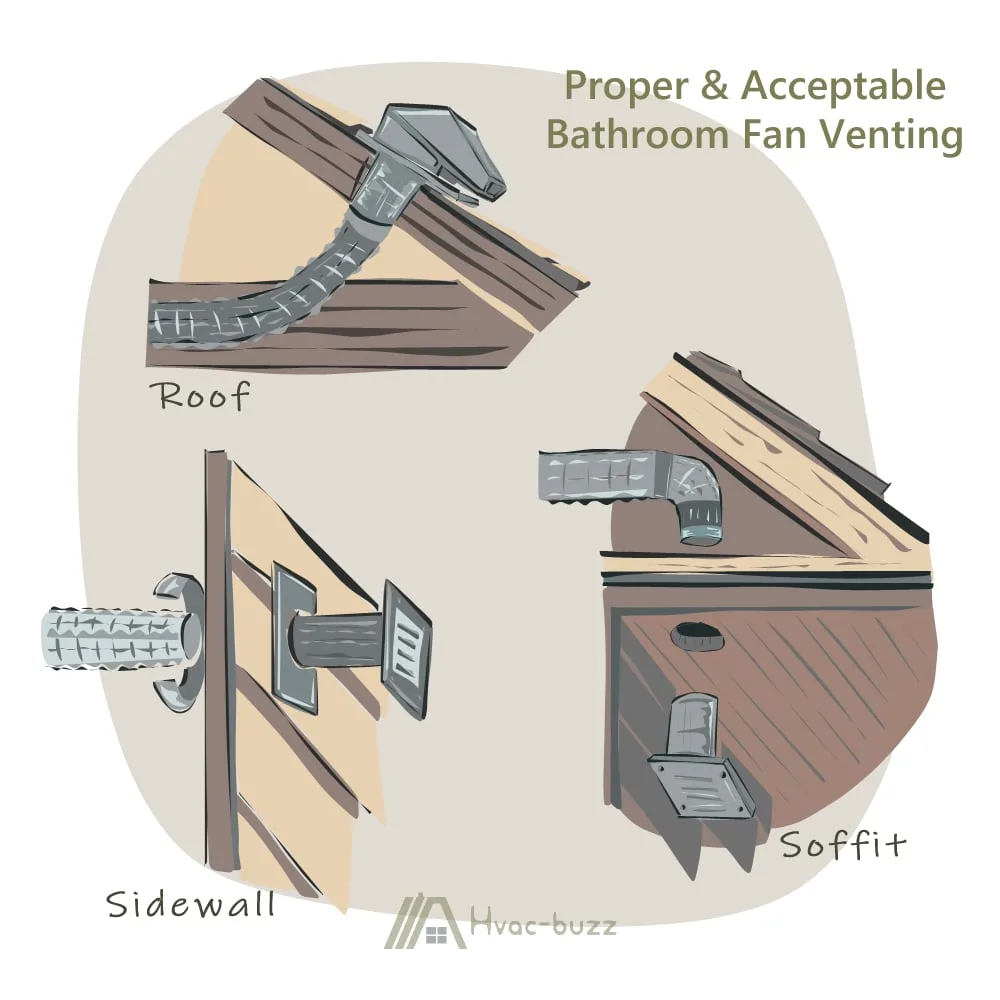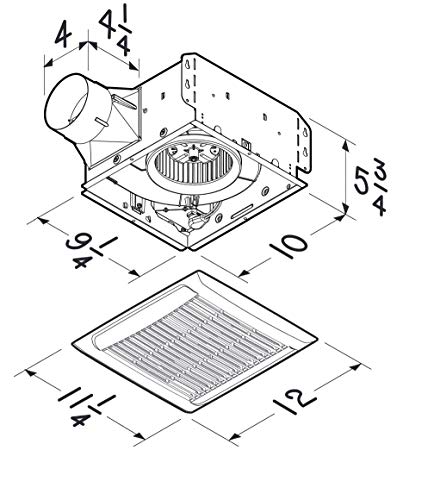Plumbing vents, ventilation ducts, pipes, and wiring. When you are installing a bathroom, you wonder how you will fit all of it in, not to mention the cost! To save a bit of space and money, I thought about hooking the bathroom fan up to the plumbing vent, but once I researched it, I realized that it was only convenient in theory. In reality, it’s a code violation that comes with some serious problems.

A bathroom fan should never be vented into a plumbing vent as this violates Section M1501.1 of the International Residential Code (IRC). The code violation will affect insurance and can be problematic when selling the house. The fan will be noisy since the plumbing vent is often too small for adequate air flow.
1. Venting Fan Into Plumbing Vent Violates Building Code
According to Section M1501.1 of the International Residential Code (IRC), you are not allowed to vent a bathroom fan into a plumbing vent:
“The air removed by every mechanical exhaust system shall be discharged to the outdoors in accordance with Section M1504.3.”
If you want to comply with code regulations, your bathroom fan should vent to the outdoors and should not vent into another vent.
Furthermore, Section M1505.2 of the IRC covers their bases by reiterating that exhausted air from bathrooms must be vented directly outside, and they also add that it cannot be discharged into any area inside the building.
Aside from the specifications for bathroom fans, Section P3101.3 of the IRC says:
“The plumbing vent system shall not be used for purposes other than the venting of the plumbing system.”
This means that it is against the codes for both bathroom fans and plumbing vents to have the two connected. Sometimes the building codes seem vague or confusing, but they are very clear on this point.

2. Code Violations Affect Insurance and Sales
Insurance
If you vent your bathroom fan into a plumbing vent, you are likely voiding any insurance claims you may have related to bathroom damage, plumbing problems, etc.
And it’s not just incidental damage that happens to involve the bathroom ventilation or plumbing. This incorrect venting can cause problems. Bathroom fans without the correct venting can often overheat, which means there is a higher risk of fires starting.
House insurance requires appliances and equipment within your house to be code-compliant in order for cover to be valid. This means that any insurance claims that occur are likely to be rejected, and you will be liable for the damages.
It may also give your insurance company a loophole to deny a claim that is not actually related in any way to the incorrect venting setup.
Sales
In terms of resale, an incorrectly vented bathroom will decrease the house and property value. Any potential buyer who faces having to redo the bathroom ventilation system is practically going to want to pay less for the house to compensate for the renovation needed.
Some buyers may also be reluctant to take on a fixer-upper which would cost them and would affect their own insurance until the problem is remedied, not to mention the health risks associated with venting the fan into a plumbing vent.
Even if a potential buyer was happy to take on the house, you would have to pay for the fix before you could get a clear home inspection certificate, which is a sales requirement.
3. Chance of Sewer Gas Entering Room Through Fan
Bad Smell
A bathroom fan that vents into a plumbing vent is going to be noticeable by the smell of ammonia that occurs when the bathroom fan is not running. This comes from the sewer gas that is leaking out of the plumbing vent.
Health Risks
Sewer gas poisoning can occur when there is extended exposure to it or if there are high levels present.
The health risks associated with sewer gas include irritation of the eyes and throat and even extremes, like organ damage. This can also lead to fatalities, so it is very important that your plumbing vents maintain their integrity.
The methane and ammonia in sewer gas are also highly flammable and, thus, are a fire hazard. Not so great if your bathroom fan motor is also overheating!
It is incredibly dangerous to have a bathroom fan connected to a plumbing vent. If you have noticed a smell and/or have experienced any health implications in your house, you should address it or call a professional as soon as possible.
The Role of Dampers
This leaking occurs because of the plumbing vent dampers being affected by the pressure difference created by the bathroom fan.
Plumbing vent backdraft dampers that are controlled by airflow and, by way of a plate or valve, prevent the backflow of air through the vent.
The negative pressure created by the bathroom fan is supposed to pull air into the bathroom from other rooms or from the compensation system. However, if it were to be connected to a plumbing vent, it may pull sewer gas through the dampers in the vent instead.
4. Plumbing Vents Are Usually Too Small
Bathroom fans require the correct size vent in order to efficiently exhaust the air from the bathroom to the outdoors.
Plumbing vents are not to be less than 1 1/4” in diameter according to the IRC Section P3113.1 and Section 906.1 of the International Plumbing Code (IPC).
A duct for a bathroom exhaust should be about 4” to 6” in diameter (although this is influenced by the size of your bathroom). The smaller the diameter of the duct, the less efficiently the exhaust fan can ventilate the bathroom.
Bathroom exhaust fans must, at minimum, be capable of a ventilation rate of 50 CFM intermittently or 20 CFM continuously as per the instructions in Section M1505.4.4 of the IRC.
This means that your duct must be appropriately sized in order to comply with the ventilation regulations, and the plumbing vents will not meet these requirements.
5. Smaller Ducts/Vents Increase Fan Noise
Bathroom fans aren’t supposed to be loud, but there are several reasons why this might happen. One of these reasons is to do with duct and vent size.
Due to pressure loss and friction, a larger fan, such as is needed in a big bathroom, will be loud if you attempt to vent it through a smaller plumbing duct.
If the duct is too small, then the air pressure drop that would occur in that duct would be greater than the permitted rate, and this would result in the air being unable to move efficiently through the vent. The more narrow the opening, the less easily the air will move through it.
In short, that means your fan will not be able to ventilate your bathroom sufficiently.
Another reason is that bathroom fans become noisier as the components wear down. More details are below.
6. Fan Works Harder With Smaller Ducts/Vents
Your bathroom fan will have reduced effectiveness when venting through a plumbing vent. As mentioned above, a smaller vent or duct will result in your bathroom fan functioning less efficiently because the airflow through the vent will be constricted, and the pressure gradient will be influenced.
The fan will have a shorter lifespan. The components for your fan will be under more strain with an incorrectly sized duct or vent. The influence on the pressure gradient and the decreased mobility of the airflow makes your fan work harder to exhaust and ventilate your bathroom.
Overheating can become a problem. With the fan being under strain and with the unit experiencing higher wear, the fan may become prone to overheating, which will impact the functionality of your fan.
Overheating of the fan is made more dangerous by the highly flammable sewer gas that can be pulled from the plumbing vent by the fan. While increasing the risk of a fire, this will also disqualify your insurance claims for damages.
Manufacturers generally insert a caveat into their warranty guarantees that proper installation is required to qualify. If your fan is installed against the coding regulations, then any manufacturing problems with your fan will not be covered should the overheating be the result of a faulty product.
7. Risk of Blocking Plumbing Vents
Lint and dust, as well as water, are pulled through bathroom fans as they exhaust humid bathroom air.
Plumbing vents are smaller and so may become clogged if these particles build up as they stick to the sides of the vent.
This build-up may also affect the movement of the dampers in the vents, causing them to not close properly, which compromises the seal of the backdraft damper and will allow sewer gas to filter back into the house.
The build-up can also affect the diameter of the vent, which will in turn influence how easily the air can move within the duct and how well your bathroom will be ventilated.
Sources
https://www.healthline.com/health/healthy-home-guide/sewer-gas#causes
https://homeinspectorsecrets.com/bathroom-exhaust-fans/how-do-bathroom-fans-work/
https://www.hvi.org/resources/publications/bathroom-exhaust-fans/
https://codes.iccsafe.org/content/IRC2021P1/chapter-31-vents#IRC2021P1_Pt07_Ch31_SecP3113.1

